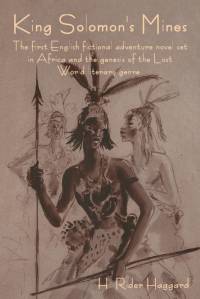Om King Solomon's Mines
King Solomon's Mines (1885) is a popular novel by the English Victorian adventure writer and fabulist Sir H. Rider Haggard. It tells of a search of an unexplored region of Africa by a group of adventurers led by Allan Quatermain for the missing brother of one of the party. It is one of the first English adventure novels set in Africa and is considered to be the genesis of the lost world literary genre.
Haggard wrote the novel as a result of a five-shilling wager with his brother, who said that he could not write a novel half as good as Robert Louis Stevenson's Treasure Island (1883). He wrote it in a short time, somewhere between six and sixteen weeks between January and 21 April 1885. However, the book was a complete novelty and was rejected by one publisher after another. After six months, King Solomon's Mines was published, and the book became the year's best seller, with printers struggling to print copies fast enough.
Andrew Lang, reviewing King Solomon's Mines for the Saturday Review, praised the book. Lang described the book as a "peculiarly thrilling and vigorous tale of adventure" and added "we have only praise for the very remarkable and uncommon powers of invention and gift of "vision" which Mr. Haggard displays".
In the process, King Solomon's Mines created a new genre known as the "Lost World", which would inspire Edgar Rice Burroughs' The Land That Time Forgot, Arthur Conan Doyle's The Lost World, Rudyard Kipling's The Man Who Would Be King and H. P. Lovecraft's At the Mountains of Madness. In The Return of Tarzan (1913), Edgar Rice Burroughs introduced his own lost city of Opar, in which the influence of King Solomon's Mines is evident. (Burroughs' Opar is supposedly the same as the Biblical Ophir with which King Solomon traded.) Opar reappeared in further Tarzan novels and was later taken up in the Khokarsa novels of Philip José Farmer and various derivative works in other media. Burroughs also introduced other lost cities in various hidden corners of Africa for Tarzan to visit, such as a valley inhabited by stray Crusaders still maintaining a Medieval way of life. Robert E. Howard's Conan the Barbarian also visited several lost cities, and Lee Falk's The Phantom was initially written in this genre. A much later Lost World novel is Michael Crichton's Congo, which is set in the 1970s and features characters seeking a trove of diamonds in the lost city of Zinj for use in electronic components rather than jewellery.
As in Treasure Island, the narrator of King Solomon's Mines tells his tale in the first person, in an easy conversational style. Almost entirely missing (except in the speech of the Kukuanas) is the ornate language usually associated with novels of this era. Haggard's use of the first-person subjective perspective also contrasts with the omniscient third-person viewpoint then in vogue among influential writers such as Anthony Trollope, Thomas Hardy, and George Eliot. (Wikipedia.org)
Visa mer

